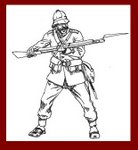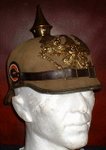When Queen Victoria came to the throne in 1837 the British Amy
was little changed from that which drove the French from the
Peninsula and defeated Napoleon at Waterloo, at least so runs the
popular idea.
In fact there had been changes, many of them for the worse. For
example commanders and staffs had nothing like the experience
in operations with large numbers of troops, supply and transport
departments...painfully built up in the early years of the Nineteenth
century, only to whither away.Uniforms had become tighter and far
less practical than in 1815. Weapons, equipment and tactics had seen
only the most minor changes. With no major European war in
prospect and with the might of the Royal Navy as a sure shield to
the homeland, the British Army was allowed to fall into a sorry
condition.
The first small note of change was sounded in 1839 with the adoption
of the percussion musket, giving the soldier far fewer misfires and
slight increases in accuracy and rate of fire. From these small
beginnings, Victoria's Army was to be in a constant state of change
....in weapons, equipment, tactics, terms of service, enemies to be
faced, and terrain to be fought over. In every field and in a degree
unknown to earlier soldiers, the Soldiers of the Queen served in an
army in a state of flux.
Up until the introduction of the Minie muzzle loading rifle in
1853, close order tactics and the two-deep line held sway (except
when skirmishing) because that was the most efficient way to use
smoothbore muzzle loading small arms. The Crimean War of 1854-
56 and, to a lesser extent, the Indian Mutiny of 1857-58, came too
soon after the introduction of the Minie and Enfield rifles for major
changes in tactics to result. In any case, the two-deep line of the
British remained as superior to Russian columns as it had to French
columns 40 years earlier.
In the late 1850's and first half of the 1860's, the British army
fought in China, Japan (if the Royal Marines will pardon my lumping
them with the army), New Zealand and on the North West Frontier
of India.The soldiers found themselves facing enemies whom in the
main relied on fire rather than shock effect, but who tended to be less
well armed than the troops.
These mainly small scale actions showed the value of open and
extended order. They made plain the fact that firepower is what
wins fights, if allied to discipline and courage. Many officers took
these lessons to heart and on the battlefields of the Empire less
was seen of close order tactics.
The adoption after 1865 of the Snider breech-loading conversion
of the Enfield gave the soldiers even more firepower. Then, in 1868,
the British came up against a new type of enemy, one they would face
again and again in the late 1870 s, 80 s and 90's. During the
Abyssinian campaign at the battle of Arogee, the Abyssinian warriors
relied mainly on a "mass charge" to try and overwhelm the troops.
British infantry in open order smashed them with volleys of Snider-
Enfield fire. In 1871 the troops were given an even better rifle, the
famous Martini-Henry. A new volume of FIELD EXERCISES AND
EVOLUTIONS OF INFANTRY was published in 1877, superceding
that of 1870 and laying much greater stress on the use of open orders
for infantry armed with the new rifles.
Between 1868 and 1879 the British soldiers saw action in Canada,
Lushai, Ashanti, Malaya, South Africa and the North West Frontier
of India before war began in Zululand.
In the Zulus the British would again face a "mass charge" enemy
and, unlike the battle of Arogee, they would not be fighting on
with steep cliffs to protect the flanks. Also, instead of 5-6,000
warriors, they would face more than 20,000 in some actions. The
Zulus were one people the British had not fought before and many
officers must have expected the fighting to be much like that in the
recent Cape Frontier War; large-scale skirmishing with badly
armed Africans of indifferent morale that superior firepower and
the new open order tactics soon put to flight.
The British Army Lord Chelmsford took into Zululand in January
of 1879 was in the midst of great changes. Short service in the ranks,
the abolition of purchase for officers, more practical (if still colorful)
uniforms, rationalized equipment, new weapons, education for
soldiers, linked battalions and new tactics had all come in the last few
years. Far from being the old fashioned force sometimes portrayed,
the British Army was as up to date, and in some respects more so,
than the armies of France, Prussia, Russia and the United States.
Yet at Isandhlwana, the British suffered the greatest defeat in their
history against a native enemy. Why? It is my belief that the causes
can be found not in the now largely disproved theory of lack of
ammunition, but in the new tactics that did not allow for an enemy
of the "mass charge" type.
I can find no example of a British multi-unit brigade or divisional
square formation between the introduction of breech-loading small
arms and the battle of Ulundi in July 1879. The British fought the
battle of Isandhlwana in extended formation not just because of lack
of knowledge as to the number of Zulus attacking them, but because
extended formations had become the normal way of fighting. I would
argue that it was the bitter lesson of Isandhlwana that led
Chelmsford to adopt the multi-unit square at Ulundi. In turn
when the British next came up against a "mass charge" enemy
in the shape of the Dervish Ansar of the Sudan, it was natural for the
British officers (some of whom had fought at Ulundi) to adopt the
square as a formation. Thus the famous "British Square" was born of
the defeat at Isandhlwana.
Far from retaining old-fashioned formations, the British had been
forced to adapt the old anti-cavalry square to meet new tactical
requirements after the new tactics of European warfare were found
to be inadequate.
Turning to the Anglo-Boer War of 1899-1902 it is often said that
British Army came into this campaign wedded to outmoded tactics.
However, when one looks at this claim, it can be shown as less than
the whole truth.
While it is true that a few British commanders preferred to operate
in close order for as long as possible, others such as Methuen and Ian
Hamilton adopted extended order right from the start of the war. It
is sometimes said that the British had "only just" ceased to wear red
coats, yet the last time red was worn in action was 1885, at Ginnis on
the Egypt-Sudan border. Khaki type clothing had been in increasing
use since the late 1840's. This compares well with the French who
were still fighting in blue and red in 1914.
Such outmoded tactics as the British troops did use tended to be
common to all major armies, indeed at Mons in 1914 German
infantry advanced in close formations that few British commanders
would have used in 1899! Criticism of British Staff work is on more
solid ground and a proper Staff was only set-up after 1902.
On the whole, the weaknesses of the British Army in 1899 were
those of all major world armies and one must doubt if the French,
Germans, Americans or Russians would have done any better
against such a skillful and mobile enemy as the Boers?
What is clear is that the British Army came out of the Victorian Era
better trained and equipped than any other in the world. Few can
doubt that the B.E.F. of 1914 was the best army in the world at that
time. Sadly, there was just too little of it.
was little changed from that which drove the French from the
Peninsula and defeated Napoleon at Waterloo, at least so runs the
popular idea.
In fact there had been changes, many of them for the worse. For
example commanders and staffs had nothing like the experience
in operations with large numbers of troops, supply and transport
departments...painfully built up in the early years of the Nineteenth
century, only to whither away.Uniforms had become tighter and far
less practical than in 1815. Weapons, equipment and tactics had seen
only the most minor changes. With no major European war in
prospect and with the might of the Royal Navy as a sure shield to
the homeland, the British Army was allowed to fall into a sorry
condition.
The first small note of change was sounded in 1839 with the adoption
of the percussion musket, giving the soldier far fewer misfires and
slight increases in accuracy and rate of fire. From these small
beginnings, Victoria's Army was to be in a constant state of change
....in weapons, equipment, tactics, terms of service, enemies to be
faced, and terrain to be fought over. In every field and in a degree
unknown to earlier soldiers, the Soldiers of the Queen served in an
army in a state of flux.
Up until the introduction of the Minie muzzle loading rifle in
1853, close order tactics and the two-deep line held sway (except
when skirmishing) because that was the most efficient way to use
smoothbore muzzle loading small arms. The Crimean War of 1854-
56 and, to a lesser extent, the Indian Mutiny of 1857-58, came too
soon after the introduction of the Minie and Enfield rifles for major
changes in tactics to result. In any case, the two-deep line of the
British remained as superior to Russian columns as it had to French
columns 40 years earlier.
In the late 1850's and first half of the 1860's, the British army
fought in China, Japan (if the Royal Marines will pardon my lumping
them with the army), New Zealand and on the North West Frontier
of India.The soldiers found themselves facing enemies whom in the
main relied on fire rather than shock effect, but who tended to be less
well armed than the troops.
These mainly small scale actions showed the value of open and
extended order. They made plain the fact that firepower is what
wins fights, if allied to discipline and courage. Many officers took
these lessons to heart and on the battlefields of the Empire less
was seen of close order tactics.
The adoption after 1865 of the Snider breech-loading conversion
of the Enfield gave the soldiers even more firepower. Then, in 1868,
the British came up against a new type of enemy, one they would face
again and again in the late 1870 s, 80 s and 90's. During the
Abyssinian campaign at the battle of Arogee, the Abyssinian warriors
relied mainly on a "mass charge" to try and overwhelm the troops.
British infantry in open order smashed them with volleys of Snider-
Enfield fire. In 1871 the troops were given an even better rifle, the
famous Martini-Henry. A new volume of FIELD EXERCISES AND
EVOLUTIONS OF INFANTRY was published in 1877, superceding
that of 1870 and laying much greater stress on the use of open orders
for infantry armed with the new rifles.
Between 1868 and 1879 the British soldiers saw action in Canada,
Lushai, Ashanti, Malaya, South Africa and the North West Frontier
of India before war began in Zululand.
In the Zulus the British would again face a "mass charge" enemy
and, unlike the battle of Arogee, they would not be fighting on
with steep cliffs to protect the flanks. Also, instead of 5-6,000
warriors, they would face more than 20,000 in some actions. The
Zulus were one people the British had not fought before and many
officers must have expected the fighting to be much like that in the
recent Cape Frontier War; large-scale skirmishing with badly
armed Africans of indifferent morale that superior firepower and
the new open order tactics soon put to flight.
The British Army Lord Chelmsford took into Zululand in January
of 1879 was in the midst of great changes. Short service in the ranks,
the abolition of purchase for officers, more practical (if still colorful)
uniforms, rationalized equipment, new weapons, education for
soldiers, linked battalions and new tactics had all come in the last few
years. Far from being the old fashioned force sometimes portrayed,
the British Army was as up to date, and in some respects more so,
than the armies of France, Prussia, Russia and the United States.
Yet at Isandhlwana, the British suffered the greatest defeat in their
history against a native enemy. Why? It is my belief that the causes
can be found not in the now largely disproved theory of lack of
ammunition, but in the new tactics that did not allow for an enemy
of the "mass charge" type.
I can find no example of a British multi-unit brigade or divisional
square formation between the introduction of breech-loading small
arms and the battle of Ulundi in July 1879. The British fought the
battle of Isandhlwana in extended formation not just because of lack
of knowledge as to the number of Zulus attacking them, but because
extended formations had become the normal way of fighting. I would
argue that it was the bitter lesson of Isandhlwana that led
Chelmsford to adopt the multi-unit square at Ulundi. In turn
when the British next came up against a "mass charge" enemy
in the shape of the Dervish Ansar of the Sudan, it was natural for the
British officers (some of whom had fought at Ulundi) to adopt the
square as a formation. Thus the famous "British Square" was born of
the defeat at Isandhlwana.
Far from retaining old-fashioned formations, the British had been
forced to adapt the old anti-cavalry square to meet new tactical
requirements after the new tactics of European warfare were found
to be inadequate.
Turning to the Anglo-Boer War of 1899-1902 it is often said that
British Army came into this campaign wedded to outmoded tactics.
However, when one looks at this claim, it can be shown as less than
the whole truth.
While it is true that a few British commanders preferred to operate
in close order for as long as possible, others such as Methuen and Ian
Hamilton adopted extended order right from the start of the war. It
is sometimes said that the British had "only just" ceased to wear red
coats, yet the last time red was worn in action was 1885, at Ginnis on
the Egypt-Sudan border. Khaki type clothing had been in increasing
use since the late 1840's. This compares well with the French who
were still fighting in blue and red in 1914.
Such outmoded tactics as the British troops did use tended to be
common to all major armies, indeed at Mons in 1914 German
infantry advanced in close formations that few British commanders
would have used in 1899! Criticism of British Staff work is on more
solid ground and a proper Staff was only set-up after 1902.
On the whole, the weaknesses of the British Army in 1899 were
those of all major world armies and one must doubt if the French,
Germans, Americans or Russians would have done any better
against such a skillful and mobile enemy as the Boers?
What is clear is that the British Army came out of the Victorian Era
better trained and equipped than any other in the world. Few can
doubt that the B.E.F. of 1914 was the best army in the world at that
time. Sadly, there was just too little of it.
































No comments:
Post a Comment